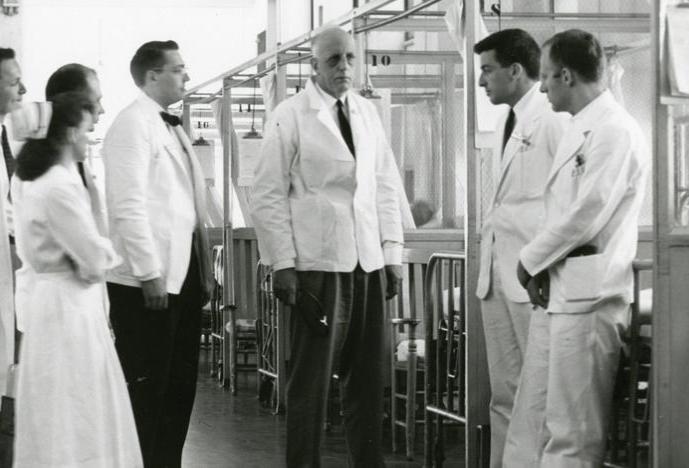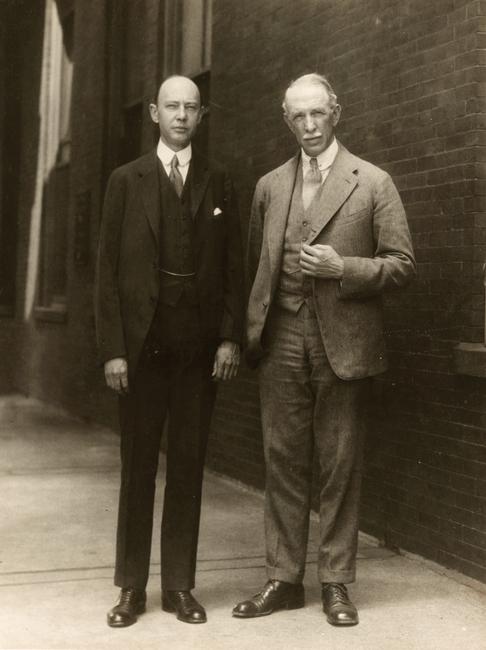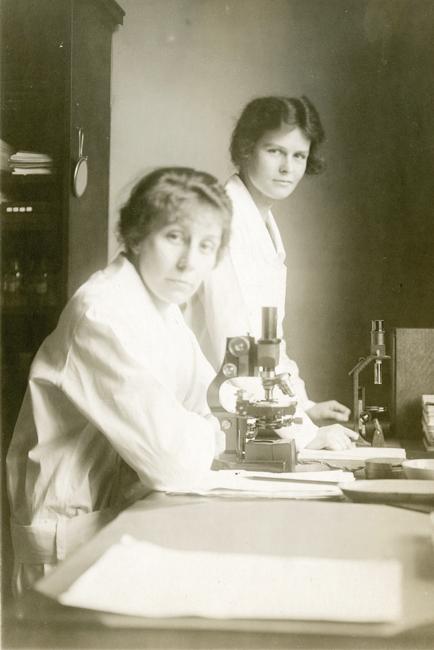At Their Service
The Harvard Medical Unit created leaders in medicine, leaving a legacy of world-class teaching, research, and patient care
- Feature

In August 1949, on a day when the temperature simmered around 105°F, Edward Kass climbed the stairs of the Thorndike Memorial Laboratory. He would soon begin a fellowship there in infectious diseases. Upon reaching the fourth floor of the Harvard Medical School-led clinical research center at Boston City Hospital, Kass was startled to find his mentor, Maxwell Finland ’26, at the bench, bare-chested and sweat-soaked. The brilliant scientist was going through stacks of cards that contained sensitivity data on various antimicrobial drugs.
“I asked him why he was working on such a miserable day,” Kass recalled years later, “and he responded, in characteristic fashion, that the only way to keep one’s mind off the weather was to immerse oneself in work.”
That sense of purpose fueled Finland’s extraordinary career as an infectious disease researcher and permeated what was then known as the Harvard Medical Unit at Boston City Hospital, a world-class program of teaching, research, and patient care that thrived from the mid-1920s through the mid-1970s. It comprised two patient-care services and the research activities of the Thorndike.
The unit was a magnet for physician–scientists eager to train with medical giants such as Finland, William Bosworth Castle ’21, Sidney Ingbar ’47, and James Jandl ’49. Its researchers had a profound influence on medicine, yielding early discoveries on infections, blood disorders, diabetes, liver diseases, and other conditions that sickened Boston City patients.
“There was an excitement and a sense of unlimited potential in the atmosphere,” wrote Kass, an epidemiologist who spent nearly 30 years at Boston City and was the School’s William Ellery Channing Professor of Medicine until shortly before his death in 1990. According to many who participated in it, the program fostered curiosity, imagination, precision, intellectual rigor, camaraderie, and pride. All that within the confines of an underfunded, overcrowded hospital with broken plumbing, supply shortages, and the grinding reality of poverty.
Goodwill to All
HMS had served Boston City since the hospital’s founding in the South End in 1864, but the School’s role expanded in the 1920s with the appointment of Francis Weld Peabody, Class of 1907, to lead its efforts there and to spearhead the construction of the Thorndike Lab, the first clinical research center in a U.S. municipal hospital. Named for surgeon William Thorndike, Class of 1848, the center housed a 17-bed ward for clinical research and two floors for laboratory investigations.

For years, Boston City was affiliated with Harvard, Boston University, and Tufts Medical Schools and was widely acknowledged as a stimulating environment for clinical research, patient care, and medical education. During the pre-Medicare era, the hospital attracted “some of the sickest, poorest, saddest, and often drunkest people you can imagine,” notes Daniel Federman ’53, HMS Carl W. Walter Distinguished Professor of Medicine. Patients didn’t know how long they’d wait, but once seen, “they knew they would receive some of the kindest, most loving, most dedicated care on Earth.”
The Harvard Medical Unit drew students, postgraduate trainees in internal medicine, and fellows focused on clinical subspecialties and medical research. What is remembered as a glorious tradition, however, ended in the early 1970s when hospital trustees, facing financial pressures and a falling patient census, decided to affiliate with BU only. Eventually the hospital was renamed Boston Medical Center.
But the Harvard program’s legacy endures: Many members have assumed leadership roles, earning positions as professors, department chairs, and deans in Boston and beyond, training new generations of physician–scientists along the way. And the names of the unit’s luminaries are attached to HMS professorships, student societies, and an annual event celebrating student research: Soma Weiss Day.
Well Springs
Advances in medicine sprang from the work of Thorndike investigators. They were a remarkably productive group, publishing nearly 100 papers during the four years before Peabody’s death in 1927 and roughly 100 papers a year during the tenures of subsequent directors George Minot, Class of 1912, and Castle. Many studies were based on clinical observations, but basic research and animal experiments also took place.
Thorndike’s research divisions, formed in the 1950s, embraced investigators who spurred progress in hematology, cardiology, infectious diseases, endocrinology, diabetes, gastroenterology, pulmonary diseases, and nephrology—and later, as medicine evolved, in genetics and other areas.
Finland and his infectious diseases group conducted seminal work on pneumonia, antibiotics, and hospital-acquired infections. This included rigorous studies of the efficacy and side effects of almost every antibiotic developed between the late 1930s and the 1970s, among them sulfonamides and penicillin. Finland’s team also documented the emergence of antibiotic-resistant bacterial organisms—in particular, gram-negative bacilli and Staphylococcus aureus—and their role in causing serious infections in patients at Boston City.
Considered the birthplace of modern hematology, the Thorndike produced crucial insights into the pathophysiology of anemia, the destruction of red blood cells and platelets, the nature of hemoglobin in normal and sickle cells, therapies for hemophilia, and classifications of lymphomas based on cell morphology. In addition, Thorndike researchers discovered that a diet rich in vitamin B12 could successfully thwart pernicious anemia, which, at the time, was a fatal disease affecting 1 to 2 percent of adults over age 50. Minot and William Murphy ’20 shared the 1934 Nobel Prize in Physiology or Medicine for this work with George Whipple of the University of Rochester. Castle extended these findings through years of study on the biological causes of pernicious anemia. As a resident, he ingested and regurgitated hamburger meat that was then fed to patients through a nasogastric tube, a clever, and, by today’s standards, alarming, experiment that demonstrated the existence of an intrinsic factor necessary for the body’s absorption of vitamin B12.
Castle wasn’t alone in volunteering himself for research. Years later, physician Victor Herbert set out to examine folate behavior in adults by eliminating the vitamin from his diet. Ronald Arky, a Thorndike fellow in the 1960s and early 1970s who studied diabetes and metabolism, recalls the effects of that self-study, “On Christmas Day in 1961, I came into the Thorndike building and found Victor, so weak he didn’t have the strength to push the elevator button.” Arky is now the Daniel D. Federman Professor of Medicine and Medical Education and master of the School’s Francis Weld Peabody Society.

The School’s research enterprise at Boston City expanded in the early 1960s with the construction of the Channing Laboratory. Led for years by Kass and now part of Brigham and Women’s Hospital, Channing is a locus for research on infectious diseases and epidemiology. The Nurses’ Health Study was begun in 1976 by longtime lab member Frank Speizer, now the HMS Edward H. Kass Distinguished Professor of Medicine, when he headed Channing’s clinical epidemiology division.
Among other accomplishments of Channing investigators are studies that advanced the diagnosis and treatment of urinary tract infections. A team led by Kass in the mid-1980s found that toxic shock syndrome, a rare but debilitating, and sometimes fatal, bacterial infection, was triggered by magnesium deficiency, an imbalance that occurred when the mineral was absorbed from the body by fibers in certain tampons. Channing scientists also helped launch the East Boston Neighborhood Health Center, which was directed for more than 40 years by chronic disease epidemiologist James Taylor, and which remains one of the nation’s most successful community health centers.
Lunch Bunch
What made the Harvard Medical Unit unusual? Former trainees and faculty point to the collaborative atmosphere, high expectations, and exceptional colleagues, nurses, technicians, office staff, and patients.
“We all spoke to one another in those days,” says Harry Jacob ’58, an intern and fellow from 1958 to 1969, who went on to head the Division of Hematology/Oncology/Bone Marrow Transplant at the University of Minnesota for nearly four decades.
“The lunchroom tables were always shared by a mixture of Thorndikers, house staff, and faculty from the three universities teaching at Boston City,” he adds. “Conversation was brisk, funny, and, uncannily, almost always engendered new ideas for laboratory research.”

“I’ve never run into a spirit of free inquiry and conviviality that matches what we had at the Thorndike during those happy years,” wrote hematologist H. Franklin Bunn, who was at Thorndike between 1964 and 1974 and is now an HMS professor of medicine in the Hematology Division at Brigham and Women’s. Bunn’s lab identified the structure and biosynthesis of hemoglobin A1c, now used worldwide for diagnosing and monitoring patients with diabetes. Mentors were supportive but demanding, Bunn adds. Research out of Thorndike dominated annual meetings on clinical investigation “because the quality of the work was remarkable. We had elaborate rehearsals, and the presentations were first-rate.”
One of the more admired mentors was Castle, who led the program between 1940 and 1963 and often chaired Saturday morning rounds, which brought in well-known physicians to discuss clinical problems. Warm, witty, and generous with his time, Castle was a father figure to many, often seeking the views of medical students, residents, and fellows on topics in biology that interested him. He loved to tinker and kept a wooden toolbox on hand in case radiators or plumbing needed repair. “When something went wrong with a sink, word went back to Castle, and the next morning you’d see this world-renowned physician–scientist under the sink fixing a drain pipe,” recalls Neal Steigbigel ’60, a house officer and fellow in the 1960s who went on to lead the Division of Infectious Diseases at Montefiore Medical Center in New York for three decades.
Finland, meanwhile, was known for his devotion to Boston City, where he spent most of his career, serving as an intern in the 1920s and directing the Harvard Medical Unit in the 1960s. He retired in 1968 as the George Richards Minot Professor of Medicine Emeritus, but remained at the Thorndike until the early 1980s.
Although always ready to provide advice and support to his Thorndike family, Finland “wasn’t a great lecturer,”says Steigbigel, “but if you asked him questions—and he particularly loved to be asked at irregular hours because it showed you were devoted to your job—he would wax eloquent on favorite subjects, such as pneumonia. He’d pull out papers and discuss them in a collegial, scholarly, and critical manner. Max was short in stature but huge in intellect and heart.” In his later years, Finland poured his energy into producing a three-volume history of the Harvard program, published in the early 1980s.
Another beloved mentor was Charles Davidson, the William Bosworth Castle Professor of Medicine, who served Boston City for three decades starting in the 1940s, and who studied cirrhosis, alcoholic hepatitis, and related diseases. He also began the morning report tradition for house staff. Former resident Walter Willett, an HMS professor of medicine and the Fredrick John Stare Professor of Epidemiology and Nutrition at the Harvard School of Public Health, credits Davidson with encouraging his interest in the association between diet, health, and disease. Joining Boston City “was a real turning point in my life,” Willett notes. “It never would have happened had Charlie Davidson not led me around the dark corridors and passageways with such enthusiasm that I knew there had to be something special about the place.”
Premium Care
Faculty and trainees alike were guided by Peabody’s philosophy of respectful and compassionate care, articulated in his famous 1925 essay, “The Care of the Patient,” which is still distributed to HMS students. “One of the essential qualities of the clinician is interest in humanity,” Peabody stated, “for the secret of the care of the patient is in caring for the patient.”
Boston City patients often had multiple problems linked to poverty and alcoholism—malnutrition, diabetes, liver disease, bacterial pneumonia, and meningitis, for example—and were seen both on wards and in outpatient clinics. HMS physicians also handled emergencies, including helping hundreds of victims after the horrific Cocoanut Grove nightclub fire in 1942.
Repeat patients often got attached to their doctors, and vice versa. “They were good, decent people; they were part of the family,” explains Robert Glickman ’64, Robert M. and Mary H. Glickman Professor of Medicine and Gastroenterology at the NYU School of Medicine. Glickman experienced Boston City as an intern and resident. “You tried your best to help. A lot of the patients were very grateful, so it was rewarding.”
That gratitude could be expressed in simple but profound ways. “I had one fellow, a regular patient in the outpatient clinic,” Steigbigel says, “who brought me a gift around Christmastime one year. I unwrapped the package and found a box of Premium saltine crackers. I was so moved and astounded.”
The School’s medical services at Boston City attracted self-reliant house officers who could react quickly and creatively to deliver the best possible care under challenging circumstances. “You had to learn things in milliseconds,” recalls Peter Tishler, a medical geneticist at Brigham and Women’s, who was at Boston City between 1960 and 1977. “It was ‘See one. Do one. Teach one.’ ”
Supplies were scarce, and medical students often “procured” rubber gloves, tourniquets, needles, and other essentials during their rotations at better-equipped hospitals. House staffers were the ultimate do-it-yourselfers, seeing to everything from collecting specimens and delivering them to the lab to transporting patients through the hospital’s slippery, inclined tunnels.
Those adventures could be hair-raising, as former resident Matthew Liang ’69, now an HMS professor of medicine at Brigham and Women’s and the chief of rheumatology at the Boston VA Healthcare System, can attest. He describes ferrying a man with end-stage liver disease and gastrointestinal bleeding along one of the tunnels. The patient weighed at least twice as much as Liang. “I took a running start up a ramp, but I didn’t have enough oomph to clear it, and the gurney drifted to the side and hit the wall,” he says. “I was helpless to prevent the collision.”
For Liang and others on the HMS unit, Boston City forged lifelong memories and connections.
“We all stood on the shoulders of those who came before us,” says Speizer, “and we all have tried to convey those lessons to the generations that have followed.”
Debra Bradley Ruder is a Massachusetts-based education and health care writer.